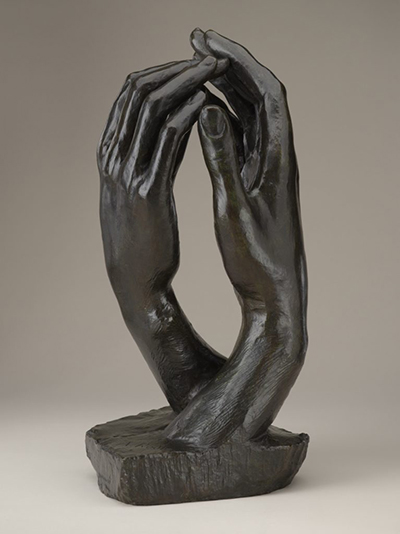This artwork by Auguste Rodin is carved in stone. It depicts two right hands, which belong to two different people. It is a beautiful creation of tenderness and fragility. It belongs to a series of similar nature, like the Secret, which is carved in marble. The other pieces are Hand from the Tomb, the Hand of God, The Hand of the Devil and Hands of Lovers.
They all have a sense of mystery and wonder. They are expressive with vulnerability, with realistic characterization. The mystery it surrounds can be interpreted in lots of different ways: lovers touching. The term Cathedral evokes spiritual thoughts but it may be a sanctuary of the mind. Rodin's passion for this particular series of works shines through. The symbolism representing various possibilities and interpretations. You see what you want to see, the tenderness and human touch, the longing, the almost spiritual bond of the hands, there is a story in every one of them, open to interpretation of the beholder.
He used the air between the spaces of the hands as a medium. He was inspired by the greats like Michelangelo and Donatello and gained success with his works, making him one of the most successful sculptors in the world. His Cathedral work was inspired by Greek Architecture. He was very meticulous in his research of realism. Some critics of his day said he had used plaster casts in order to do this. But this was untrue, as he often had his models parade around in the nude, so he could observe every aspect of the body and portray it as realistic as possible in his works. He observed the muscle movement and shape of the human body, so he could portray it as realistically as possible. (Rodin on Art and Artists).
Some people have remarked on the forbidden love aspect of the hands, as he’d been in a long-term relationship with Rose Beuret and had fallen in love with someone else. The object of his desires was Camille Claudel, who was one of his models and 25 years his junior. He never did leave his wife, so Camille broke off their affair. Perhaps the artwork portrays his yearning for being with the love of his life. It was produced some ten years after the affair, so maybe the piece depicts his longing for her and the fact they will never again be together. The space between the hands could depict the distance between them and the ongoing yearning between the two. The expressionism of the work encapsulates his feelings. After his death in 1917, many of his works were reproduced in bronze, under license of the museum. Cathedral is currently on display in the Museo Soumaya in Mexico City.




